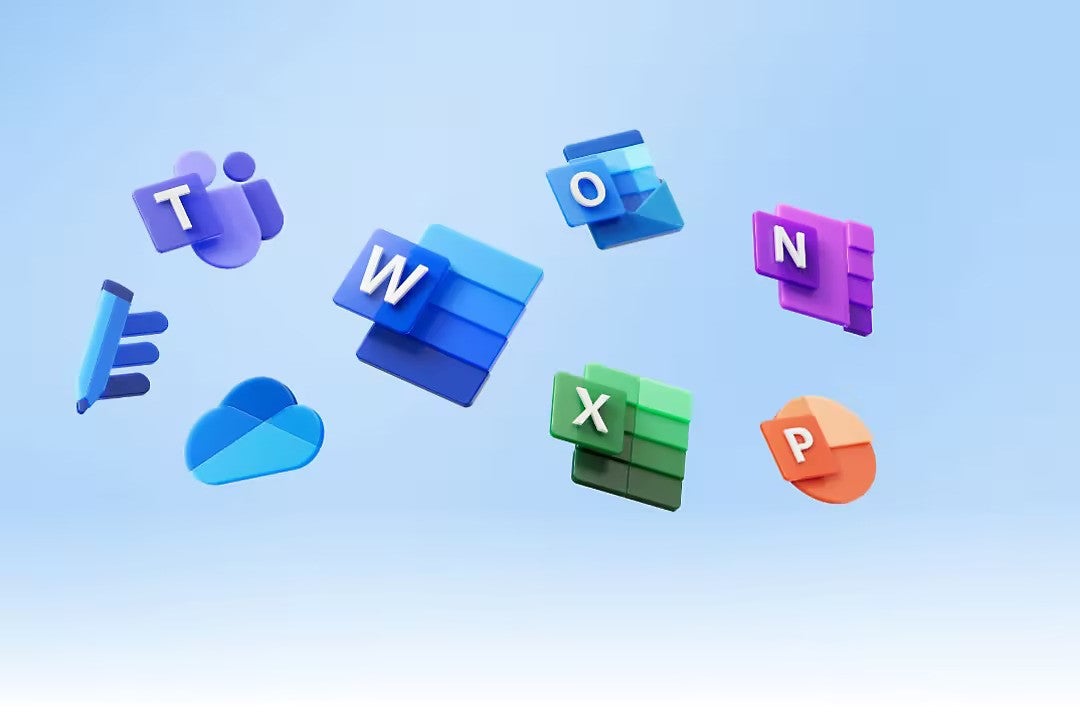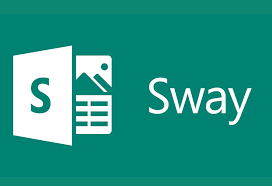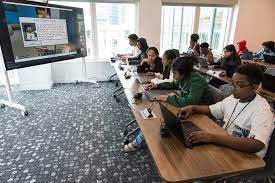Home » Posts tagged 'collaboration'
Tag Archives: collaboration
Global Collaboration
After reading “Transform Learning through Technology” a specific section gives teachers insight on the connected learner and ways of how the collaboration of technology can help further advance a classroom. This page focuses on three indicators (p.10) 1. A call to action to actively pursue professional learning 2. Directs you on to a path of finding that learning, as effective coaches are active in professional learning networks. 3. Has coaches establishing shared goals with educators to extend and enhance learning. Globally, technology has expanded for educators in a multitude of ways including, educational learning apps, social media, networks specifically for teachers in the field. Examples like Microsoft teams offer educators a way to connect by sharing lesson plans in groups, teaching resources, and parent-teacher communication that has not been done before and is available worldwide.

Wakelet Tools
In the textbook, Sail the 7 C’s, I was able to access a Wakelet that provided me with a variety of tools that can be utilized in classrooms to stimulate learning. I comprised a list of my favorites.
Microsoft Forms
Microsoft forms allows educators to survey and assess students virtually, allowing for more accessibility. If a student is not present in the classroom, they can still participate via these forms. This tool allows teachers to create quizzes, polls, and surveys while also allowing anonymity. This tool would also be great for allowing students to quiz their peers on what they know as a study material.

Sway Life Stories
Sway Life Stories is an app that allows users to creatively use pieces of art in presentations. Videos, pictures, and text can be inserted into a presentation that can be gone through at your own pace. Sway Life Stories also allows several people to access the same presentation at once, further allowing learning at your own pace.
Flipgrid
Flipgrid is a tool that I am intimately familiar with, as I have used it for courses before. Educators can assign a question that a student answers in video format. The student can then proceed to watch their peers’ content and comment in text or video form. Flipgrid allows students to convey their knowledge in an informal context while simultaneously allowing students more comfort and pushing them out of their comfort zones.
Global Kids: Bridging the Gap Between Cultures and Communities

The company Barefoot Books has been providing educational tools for teachers since 1992. One of those tools is the Global Kids set, providing recipes, games, crafts, and other useful activities revolving around different cultures to diversify students’ worldviews.
This tool can be useful to engage students in learning on a more personal level. Students will be able to relate and participate in other traditions and compare those to the ones they participate in. Overall, this can create deeper empathy within students. I would use this with my class frequently, for reading activities and crafts. There could even be a dedicated day used for creating some of the recipes! Barefoot Books strives to create connections worldwide between students and says even more on the matter in their About Me .
Sources:
The Uncensored Library: A Global Collaboration for Knowledge

Many people agree that knowledge is power, so what can be done when knowledge is easily accessed. With new-age technology, many people have access to the world at their fingertips. Unfortunately, this means that censorship is also a prevalent issue. When oppressive governments restrict the press and social media, where can people go?
Reporters Without Borders: An Organization for Change
Reporters Without Borders (RSF) is an organization dedicated to fighting censorship and the limiting of knowledge. These advocates and reporters create petitions and push for global change. Their biggest project is The Uncensored Library, a minecraft server. While social media and news outlets are the first to be restricted by oppressive governments, a children’s sandbox video game is not even high up on the list, so RSF have taken advantage of that. They use a Minecraft feature, books and quills, to transfer restricted works into Minecraft, so that anyone can access them.
Collaboration for the Better
The Uncensored Library is a beautiful example of global collaboration. People from all over the world come together and work together to distribute information to populations that can not access it. While petitions and governments can be pressured to lift censorship laws, it does not happen overnight. The Uncensored Library ensures people can still stay informed while change is being pushed for.
Sources:
RSF (2020) The Uncensored Library
Virtual and Augmented Reality for the Classroom
Advancements in technology have allowed for classroom to become more direct in how any lessons can be applied to the ‘real world’. One of the best ways to through virtual reality (VR) and augmented reality (AR). These pieces of technology can allow for students to explore fictional worlds, or map out how something may exist in front of them. It is important to distinguish the difference between the two reality-influencers. VR acts as a total reshaping and changing of what the user is seeing, it manipulates the whole environment; instead of being in a classroom, the student could be in a museum across the country. AR adjusts to the environment it is used in, and simply adds or subtracts the desired subjected from the view of the user; students could see how large a bear is in comparison to them by using AR to make it look like a bear to right next to them in their own classroom.
VR Tools in the Classroom
If you are looking to extend your students’ awareness and collaboration, you should definitely try out VR and AR tools in the classroom! They allow for students to see how things look in other places in the world, and how objects would look in their own spaces! One great tool to use in the classroom is Nearpod. Nearpod allows for teachers to create interactive lesson reviews for students, all the students have to do is enter the code to the Nearpod and they’ll be in! That’s not all, Nearpod also has a VR system!

Using Nearpod for Global Collaboration
Nearpod has a fantastic function for educators who want to show their students environments from all over the world! When choosing the interactive slide you want your students to see, there is an option for “Virtual Field-Trip”, which can be used to bring your students on a virtual field trip to so many locations! Check out the video below to see how you can add virtual field trips to your own Nearpod!
How does this circle back to collaboration? Well, thinking back to the stories we read in our “Seven C’s” book this semester and the global goals project, it is easy to see how using this feature of Nearpod brings great opportunities for students to get involved! By showing students different environments, whether it be to see how humans impact wildlife or to see the living conditions of other people, showing students what exists in the world is a great way to get them involved with projects such as global goals. For instance, if your students are learning about human impact on the environment, show them the environment from the lesson, and have them discuss ways to clean up, or use Nearpod with students from a classroom across the world and show each other how they live day to day! Nearpod holds endless possibilities for students to collaborate with their peers both inside and outside the classroom to make the world a better place to live! Maybe you don’t know where to start in your virtual lesson, but that’s okay, here is a resource I found that may bring some inspiration for what lessons you can create!
Conclusion
Don’t be afraid to try out new teaching methods, students thrive on being able to learn in different ways, and what better way to spark their imagination than by providing them an almost-real-life experience that VR and AR can bring to a classroom!
Citations
Nearpod: https://nearpod.com/nearpod-vr
Youtube video: https://www.youtube.com/watch?v=AvFpI2l2yXE
Global Goals webpage: https://www.globalgoals.org/
Lesson plan inspiration: https://www.classvr.com/category/virtual-reality-teacher-lesson-ideas/
The multimodal functions of Sway
The internet has provided opportunities for connection and community all across the world. In chapter 2 of “Sail the 7 Cs with Microsoft Education”, there are countless stories of how communities were strengthened and built from different web tools, but perhaps the most touching was the one done through Sway.
Sway
Sway is a website built on expanding the experiences often seen in presentation tools such as PowerPoint and Google Slides. Instead of having blocked or sectioned areas, Sway operates as a flexible “story-telling” app by Microsoft to create a more interactive experience. When creating something on Sway, you can use videos, photos, and more to recreate or simulate a desired moment. That is exactly what Lee Whitmarsh helped to achieve in Alsager, England.

Sway Used to Better Life
Whitmarsh had students paired with couples in which one partner suffered from dementia, and had them use Sway to gather memories and mementos to help restore memories lost by the one partner. This process even continued after the project ended, with family members adding onto it regularly. This tool not only provides a more enjoyable presentation experience for students, but it also operates as an item to improve daily life for many people.
Textbook Learning
It is often overlooked how important the resources cited in a text can be. Whether it be scientifically, in a storybook or biography, appreciating the cited sources and tools provided by a piece of text allows not only for a better comprehending of what has been read, but also how to use it for yourself. This week’s reading is proof of that. With so many tools that I had been previously unaware of, it truly is a marvel how many different uses can come from one tool.

Conclusion
The beauty of “Sail the 7 Cs with Microsoft Education” is the varying tools it introduces you to. Prior to this week’s chapter, I had never even heard of Microsoft Sway. I took a look at the website after reading the chapter, and it truly is a great tool that can be used for any reason. It offers templates for blogs, newsletters, reports, resumes, presentations; there are endless possibilities on Sway. I think that using Sway as a main source for really any project would prove to be fruitful, with so many outcomes possible, Sway would aid any person in their day to day life. I learnt about a tool that I now may use in the future for my own projects. The value of Sway is unmeasurable, as seen in the story from this week’s reading, and I truly think that this tool is one that everyone should know about.
Citations
Keene, B., & Kersznowski, K. (2020). Sail the 7 Cs with Microsoft Education: Stories from around the World to Transform and Inspire Your Classroom. Dave Burgess , Incorporated.
Resources
Students and Global Goals
Do our students really know what is going on around in the world? Do they understand how us as a community can come together to change that negativity? A published article, Global Education Checklist, helps teachers and other school employees find out how to teach goals to students. The checklist provides what the children should know for each of the discussed goals. For example, it talks about the library. It asks educators if books involving global goals are available for students, are the books diverse talking about all different ethnicities, are items up to date, and more. This checklist helps so much for educators to make sure everything is in check to properly teach and include all children. There is a scale provided to help the educators rate how well the school does on a scale of 1-4 with the global education. There is a section asking about the textbooks provided, there is a state/institutional checklist, state standards and curriculum. This part is the section for state educators’ agencies. Overall, this is such an amazing checklist, that all educators should take a look at. The checklist goes for all K-12 students, all the schools should have this checklist gone over and each Indvidual teacher. For the future, in my classroom I will always be sure it fits all these requirements, it is so important to expose children of all ages to the global topic. Making sure to have an inclusive and safe environment for all of the future students I will have!
Using Collaborative-Technology to Improve Learning
Advancements in School Technology
Every year, educators are discovering new uses for technology in the classroom. Over the past five years, more and more schools have been adding various forms of technology to classrooms. Whether it be tablets, laptops, or other tech, these additions to the educational world means educators have to figure out one thing-how to possibly include these devices into daily lessons and work.
Technology for Collaboration
Technology can be a wonderful tool to increase collaboration amongst classrooms, and many educators have realized this. With all of the apps and websites that can be found on the internet, it is no surprise that the brilliant minds of educators found endless ways to use those apps to their advantage.
Video Collaborations
The internet has allowed for people (who would otherwise seem worlds away from each other) to be able to communicate and connect with others from all over the world. One such app that can be used to promote connection is Skype, a platform from 2003, that is still usable today. Teachers have been able to use this platform to have their students interact with other students from different countries. Stacey Ryan, a teacher from Kansas, USA is just one example. After her students connected over Skype with students from Kenya and seeing how their lack of resources affected their lives, her students were able to collaborate and raise money to have a new water system implemented into the area those students in Kenya were from! All of that work would never have happened the way it did were it not for the wonderful collaboration and connection made possible by technology!

The Use of Popular Kid’s Media in Classrooms
Often times, there is a disconnection between students and teachers K-12. Part of this disconnect comes from a lack of interest in material that younger students have a hard time relating to. The solution – incorporating popular media into your lesson plans. Now, this does not necessarily mean that the way to a student’s heart is through memes and playing songs in the classroom during independent work times, but using known and pre-existing platforms to encourage students to interact with each other. One such platform is actually the 2009 videogame Minecraft. This beloved game is known as a “sandbox” game, which means that the player can do whatever they want, how they want, and when they want. The world created within the game can be manipulated in any way, and most importantly, can be accessed by multiple people. In 2016, Minecraft got an update to be used in classrooms, “Minecraft: Education Edition”. This specific part of the platform allows for the game to be used by educators to help students create, learn, and collaborate with other students. The best part is, this platform can be used for any subject: math, science, literature, history, and more! Use the game to recreate a story from a book your students read, allow them to help each other discover ways to best convey a scientific comparison between the game and the real world. You can even have students play “survival mode”, which forces the player to hunt and gather materials to mimic how life had been like in the past.

The Whole Picture
Though there is hesitance from all parties (parents, teachers, students) it is important to note that with the constant evolving of technology in the world, knowing how to use technology in the classroom is key to helping students prepare for the world ahead of them. By using modern technology, students have access to new learning platforms, collaborations with other students, and even more power to change the world through communication and collaboration!
Keene, Becky, and Kathi Kersznowski. “Collaborators .” Sail the 7 Cs with Microsoft Education: Stories from around the World to Transform and Inspire Your Classroom, Dave Burgess Consulting, Incorporated, San Diego, 2020.
Global Collaboration and its Benefits
Global Collaboration has more benefits then just extending ones knowledge and understanding in educational subjects, it can also help students better understand their peers, their emotions, social interactions, and the whole world outside of their community. Introducing students to a wider world can inspire them to explore, to create, or to make changes happen where needed. While technological advances can be intimidating, having the tools to connect with people in different countries can expand the younger generations mind and create new ideas to better our society and planet. Gosia Jaros-White discusses in their article titled “Four Amazing Benefits of Global Collaboration,” the gains of global collaboration that touch on subjects outside of classroom knowledge.
Inquiry-Based Learning
Inquiry-based learning focuses on letting the student guide what they want to know, bringing attention to their questions or ideas. Global Collaboration is a great way to trigger this kind of curiosity that engages students in their own learning, making them more excited to come to class. In their article, Gosia Jaros-White writes, “in global collaboration projects students ask questions and make observations about their peers” (Jaros-White, 2023). Allowing students to explore their curiosity cannot only expand their knowledge on certain subjects, leading them to inquire for more answers, but also keep them engaged in the classroom.
Diversity/Common Ground
When communicating virtually with students all over the world means they will naturally notice differences from where others live including different accents, ethnicities, clothes, and more. This allows them to have a deeper appreciation for diversity and learning more about different cultures around the world. It also allows them to find a common ground with others that allow the differences and distance to not seem so large. Finding this common ground leads the students to not only be talking to someone across the globe, but a new friend as well. As the author states in their article, “discovering that their global partners listen to the same K-pop artists or read the same manga books leads to rich discussions and deeper connections with people they wouldn’t normally interact with before” (Jaros-White, 2023).

Students becoming Teachers/Empathy
One thing that comes along with talking to students from countries across the globe, is the sharing of knowledge. Having the students interact with one another can allow them to help others in different subjects or projects and answer questions. That is not the only way students can become teachers as seen by the example given by Gosia Jaros-White, who states that sharing phrases or words in languages that others are trying to learn can aid in the process (Jaros-White, 2023).
Every person has a different life and face different challenges, and giving students the opportunity to comprehend the challenges those from around the world may face can allow their empathy to grow and inspire them to create change. There are examples all over the world of children stepping up; raising money, hosting fundraisers, and more for different causes. Global Collaboration can only expand on this, providing them with the chance to help others and with virtual meetings, they won’t just be helping a group of kids their age, but their own friends or peers (Jaros-White, 2023).
Closing
There are many benefits to global collaboration and as it is used in more classrooms, they will only grow. The article used today only discusses merely a few that I believe are important for educators to know as they decide whether or not to implement global collaboration into their classroom. There are so many ways technology can be used in the classroom to help students and expand their knowledge, and not just on school subjects, and it can all be done in quick, simple steps with more educators building a community online everyday.
Citations
Jaros-White, Gosia. “Four Amazing Benefits of Global Collaboration.” Level Up Village, 10 July 2023. https://levelupvillage.com/four-amazing-benefits-of-global-collaboration/
Worldwide Education Collaboration and the Importance of Transnational Education
By Troy Deman
Introduction
Since the dawn of humanity, we have benefited from the sharing of knowledge and collective learning across towns, cities, countries, and entire societies. We help teach those around us new ideas and information and as a result we collectively collaborate to progress not just as separate people but as spices as a whole. While collaborating through the sharing of ideas and knowledge in classrooms is common today, many people don’t think about the collaboration of education and its resources across separation nations. However, in recent years a new system has emerged to help provide new educational opportunities and resources to peoples who lack it most. This system is called Transnational Education or TNE.
What is TNE and what does it do?
Transnational education is essentially “all types of higher education study programs, or sets of courses of study, or educational services (including those of distance education) in which the learners are located in a country different from the one where the awarding institution is based” (Riga, 2001). Through TNE programs, higher education institutions like universities are working with each other to provide educational opportunities and share knowledge to countries and people outside of the country the institution resides. This is a game changer for countries that lack sufficient higher education opportunities as universities can share their resources and collaborate with countries outside their own to provide education to regions that lack it. This program will help humanity overtime increase the spread of and access to high quality education across the globe.
“Institutions are increasingly recognizing the value of global collaborations in TNE. Joint ventures between universities, cross-border partnerships and collaborative research initiatives are on the rise. These collaborations not only help widen access to international education and meet local demand, but also contribute to enhancing the quality of education internationally, supporting the development of local capacity and the creation of richer and more diverse learning experiences” (Riaz & Trifiro, 2024).

Drake, D. & InBusiness. (2015, May). Making Global Connections Work. InBusiness Greater Phoenix. https://inbusinessphx.com/partner-section/making-global-connections-work.
Benefits to TNE
There are other benefits to TNE programs as well including.
- lower tuition fees than mobile international students
- Better gender eqaulty
- Much more flexable for working students
- Preventing brain drain on the countries using TNE
Conclusion
This program will help humanity overtime increase the spread and access to high quality education across the globe. TNE will help humanity reach a future where different peoples, ethnicities, and cultures around the world all have access to high quality education which will in turn increase the diversity of human thinking and improve the collective learning of the planet.
“TNE serves as a bridge, connecting individuals, institutions and education systems across the globe, in the process helping to foster that shared understanding and sense of global citizenship required for peaceful and constructive relations between our increasingly interconnected communities” (Riaz & Trifiro, 2024).
Thanks for reading through my 2nd blog, if you want to see more check out the original article linked here The untapped value of transnational education. Also check out Nishat Riaz on twitter at https://twitter.com/nishatriaz where I originally found the article.
Citations
Riga. Code of Good Practice in the Provision of Transnational Education, 2001, www.cicic.ca/docs/TNE-Code2001.en.pdf.
Riaz, Nishat, and Fabrizio Trifiro. “The Untapped Value of Transnational Education.” University World News, 27 Jan. 2024, www.universityworldnews.com/post.php?story=20240126230211149.
